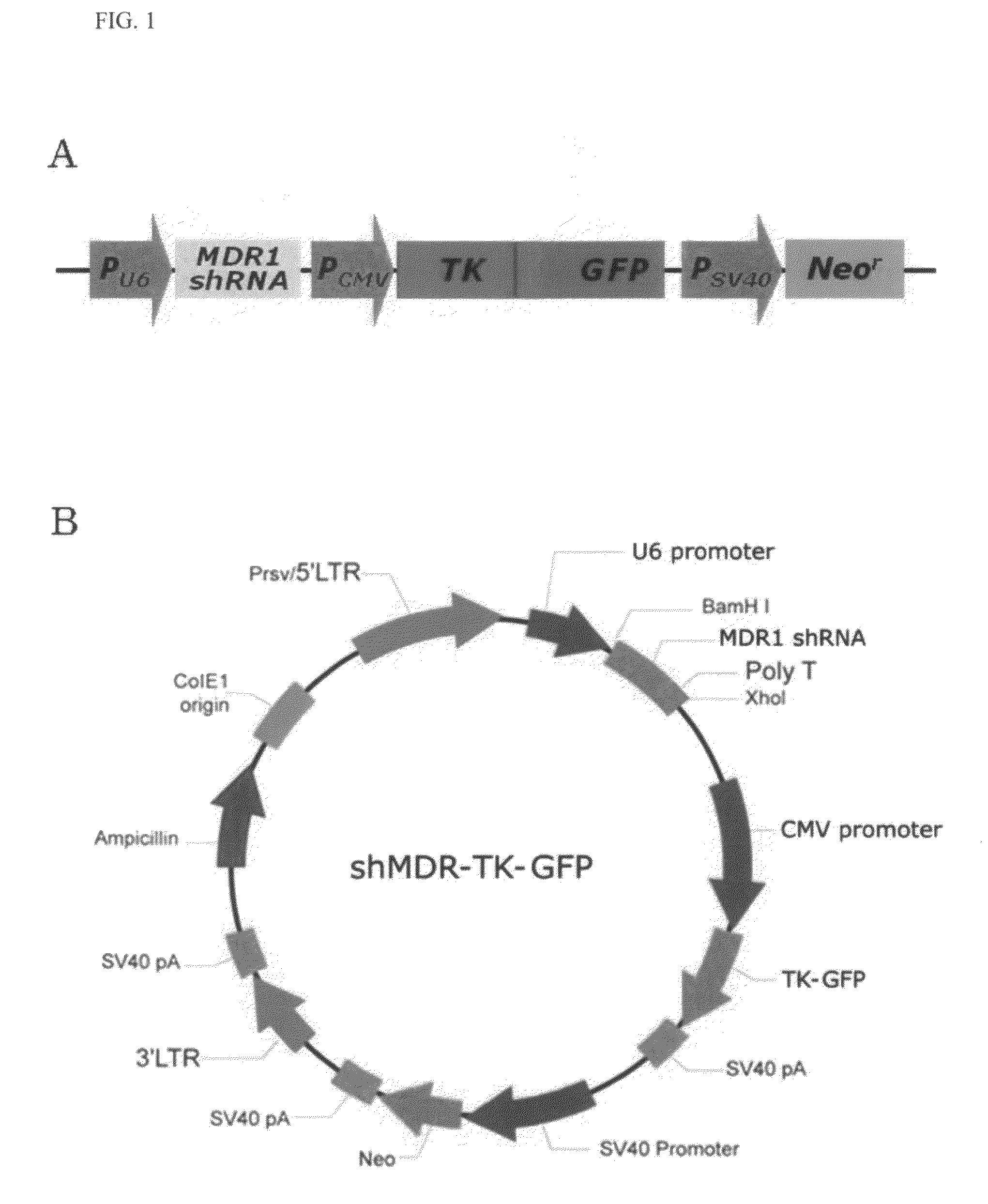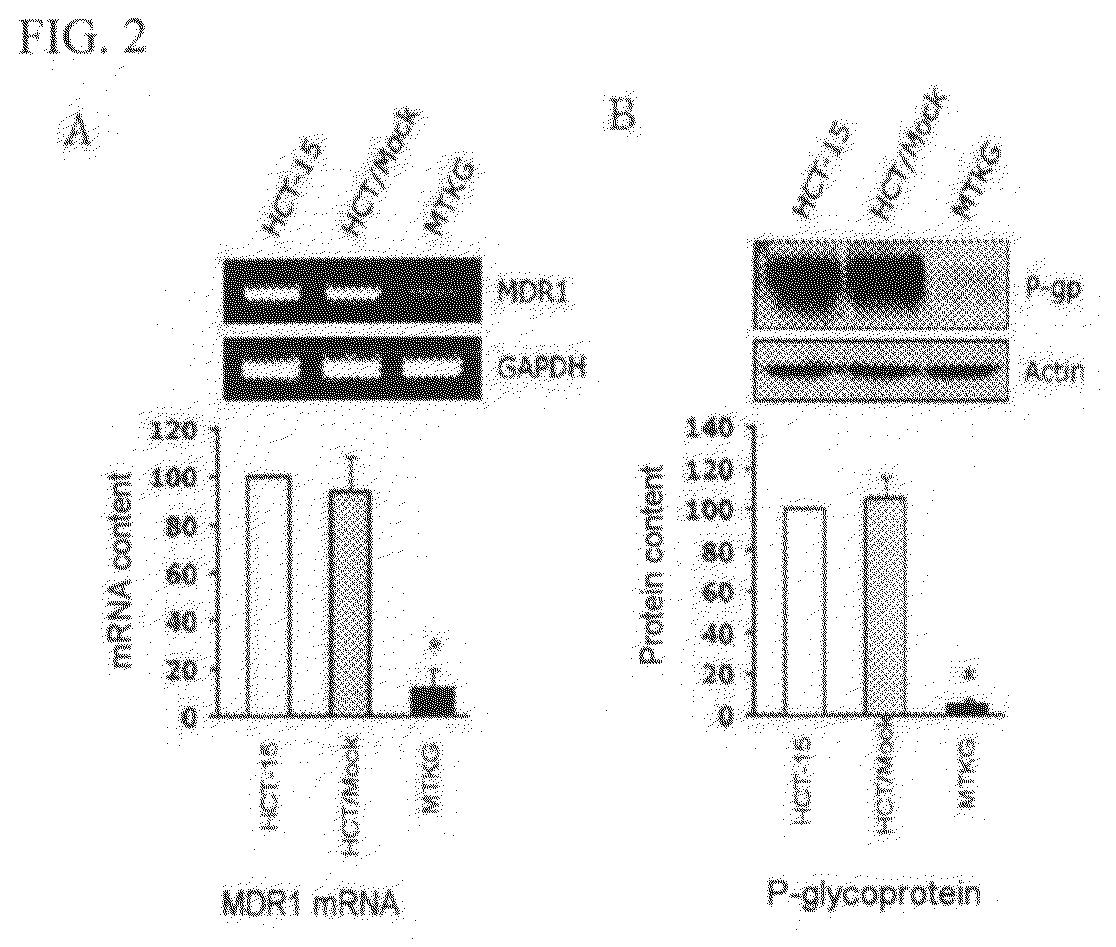Recombinant vector expressing MDR1 shRNA and thymidine kinase and use thereof
a kinase and mdr1 technology, applied in ester active ingredients, tissue culture, enzymes, etc., can solve the problems of high mortality of cancer patients, cytotoxicity of most chemical anticancer drugs on normal cells, and death of individuals, so as to maximize the anti-tumor effect and achieve effective methods
- Summary
- Abstract
- Description
- Claims
- Application Information
AI Technical Summary
Benefits of technology
Problems solved by technology
Method used
Image
Examples
example 1
Cloning of Vector with Co-Expression of MDR1 shRNA and Thymidine Kinase Gene
[0067]1-1. Construction of HSV-Thymidine Kinase / GFP Fusion Gene
[0068]For construction of a fusion gene of a Herpes simplex virus-thymidine kinase (HSV-tk) gene and a GFP (green fluorescent protein) gene (hereinafter, referred to as “TK-GFP gene”), PCR amplification was carried out using HSV-tk cDNA (by courtesy of Dr. Jae Yong Park, Department of Internal Medicine, Division of Pulmonary, Medicine College of Kyungpook National University, Korea) as a template, and primers having sequences as set forth in SEQ ID NOS: 7 and 8. PCR was carried out as follows: initial denaturation of template cDNA at 94° C. for 2 min, followed by 30 cycles of denaturation at 94° C. for 30 seconds, annealing at 60° C. for 30 seconds and extension at 72° C. for 1 min. The amplified PCR product was cleaved with Nhe I and BamH I restriction endonucleases and ligated into the same restriction sites (Nhe I and BamH I recognition sites)...
example 2
Expression of MDR1 shRNA in Transfected Cells
[0077]2-1. Analysis of mRNA Expression
[0078]Expression of MDR1 shRNA in MTKG cells of Section 1-3 of Example 1 was examined by RT-PCR For this purpose, total RNA was isolated from HCT-15, HCT / Mock, and MTKG cells, using Trizol reagent (Invitrogen) according to the manufacturer's instructions. Then, cDNA was prepared using 2 μg of the isolated total RNA as a template, and Oligo(dT)15 primer (Bionics, Seoul, Korea) and reverse transcriptase (Promega). PCR amplification for MDR1 mRNA was carried out using the prepared cDNA as a template and a pair of primers (SEQ ID NOS: 12 and 13). PCR was carried out as follows: initial denaturation of template cDNA at 94° C. for 2 min, followed by 30 cycles of denaturation at 94° C. for 30 seconds, annealing at 60° C. for 30 seconds and extension at 72° C. for 1 min.
TABLE 2Primers for MDR1 amplificationSEQ IDPrimersSequencesNOMDR1 sense5′-gga gtg tcc gtg gat cac12a-3′MDR1 antisense5′-aat aca tca ttg cct g...
example 3
Expression of TK-GFP Gene in Transfected Cells
[0083]3-1. Analysis of Protein Expression
[0084]In order to examine expression of an intracellularly incorporated TK-GFP gene, Western blot analysis was carried out in the same manner as in Section 2-2 of Example 2, except that anti-GFP antibodies (clone B-2, Santa Cruz, USA) were used for proteins isolated from HCT-15, HCT / Mock, and MTKG cells.
[0085]From the experimental results shown in FIG. 3A, it can be seen that the MTKG cells exhibit significant expression of the TK-GFP fusion protein, as compared to a control group.
[0086]3-2. Fluorescence Analysis
[0087]In order to further examine expression of an intracellularly incorporated TK-GFP gene, MTKG cells were observed under a light microscope and a fluorescence microscope, respectively.
[0088]From the experimental results shown in FIG. 3B, it can be seen that all the cells observed under the light microscope exhibited the fluorescence of the GFP protein upon examination of the cells under...
PUM
| Property | Measurement | Unit |
|---|---|---|
| pH | aaaaa | aaaaa |
| pH | aaaaa | aaaaa |
| resistance | aaaaa | aaaaa |
Abstract
Description
Claims
Application Information
 Login to View More
Login to View More - R&D
- Intellectual Property
- Life Sciences
- Materials
- Tech Scout
- Unparalleled Data Quality
- Higher Quality Content
- 60% Fewer Hallucinations
Browse by: Latest US Patents, China's latest patents, Technical Efficacy Thesaurus, Application Domain, Technology Topic, Popular Technical Reports.
© 2025 PatSnap. All rights reserved.Legal|Privacy policy|Modern Slavery Act Transparency Statement|Sitemap|About US| Contact US: help@patsnap.com



